Numerical Study on Wave-Ice Interaction in the Marginal Ice Zone
Abstract
1. Introduction
2. CFD Numerical Simulation
2.1. Governing Equations
2.2. Turbulence Model and Free-Surface Treatment
2.3. Numerical Wave Tank
2.4. Numerical Model Ice
3. Description of Wave–Ice Model Test
4. Results and Discussion
4.1. Wave Accuracy Verification
4.2. Influence of Wavelength on x, y, and z Motions
4.3. Influence of Ice Shape on x, y, and z Motions
4.4. Influence of Ice Thickness on x, y, and z Motions
4.5. Influence of Ice Size on x, y, and z Motion
4.6. Overwash
5. Conclusions
- (1)
- After comparing the CFD and EFD (experimental fluid dynamics) results of RAO at different wavelengths, it is inferred that the numerical results agree optimally with the experimental results. Under the action of wave diffraction and scattering, the RAO value initially increased and then stabilized with an increase in wavelength.
- (2)
- Under the action of waves, ice floes produced a violent motion. In different conditions, the longitudinal translation, vertical heave, and pitch motions were significant and maintained a certain consistency. The motion of ice floes along the x-, y-, and z-axes is related to wavelength, ice size, ice thickness, and ice shape. When the wavelength was greater than 1.8 m, the drift distance along the x-axis decreased with an increase in wavelength. The ice floes rotated periodically along the y-axis and the rotation amplitude along the y-axis decreased as the wavelength increased. The translational motion along the z-axis was steady when the wavelength is small, but the reciprocating motion along the z-axis was intensified as the wavelength increased.
- (3)
- Under the same wave parameters, the circular floating ice C1 exhibited the longest drift distance along the x-axis, followed by the triangular floating ice T1; however, the square floating ice exhibited the closest drift distance. The shape of the ice has no significant influence on the motions of the y- and z-axes. The ice thickness exerted a negligible influence on the motions of the x, y, and z directions. The ice floes with the smallest sizes exhibited the longest offset distance along the x-axis, and the motion difference of the y- and z-axes, relative to size, was insignificant.
- (4)
- In this study, the overwash of different shapes of floating ice was analysed at different times. It was inferred that the overwash phenomenon was the most significant at T = T0 for any shape of floating ice, and the overwash changes with the wave period.
Author Contributions
Funding
Institutional Review Board Statement
Informed Consent Statement
Data Availability Statement
Conflicts of Interest
References
- Lee, C.M.; Cole, S.; Doble, M.; Freitag, L.; Hwang, P. Marginal Ice Zone (MIZ) Program: Science and Experiment Plan; Technical Report; Washington University Seattle Applied Physics Lab: Seattle, WA, USA, 2012. [Google Scholar]
- Kohout, A.L.; Meylan, M.H. An elastic plate model for wave attenuation and ice floe breaking in the marginal ice zone. J. Geophys. Res. Oceans 2008, 113. [Google Scholar] [CrossRef]
- Dumont, D.; Kohout, A.; Bertino, L. A wave-based model for the marginal ice zone including a floe breaking parameterization. J. Geophys. Res. 2011, 116, 241–253. [Google Scholar] [CrossRef]
- Toyota, T.; Kohout, A.; Fraser, A. Formation processes of floe size distribution in the marginal ice zone (Invited). Blood 1998, 92, 1297–1307. [Google Scholar]
- Marchenko, A.; Wadhams, P.; Collins, C.; Rabault, J.; Chumakov, M. Wave-ice interaction in the north-west barents sea. Appl. Ocean Res. 2019, 90, 101861. [Google Scholar] [CrossRef]
- Kovalev, P.D.; Squire, V.A. Ocean wave/sea ice interactions in the south-eastern coastal zone of Sakhalin Island. Estuar. Coast. Shelf Sci. 2020, 238, 106725. [Google Scholar] [CrossRef]
- Squire, V.A.; Dugan, J.P.; Wadhams, P.; Rottier, P.J.; Liu, A.K. Of ocean waves and sea ice. Annu. Rev. Fluid Mech. 1995, 27, 115–168. [Google Scholar] [CrossRef]
- Toyota, T.; Haas, C.; Tamura, T. Size distribution and shape properties of relatively small sea-ice floes in the Antarctic marginal ice zone in late winter. Deep Sea Res. Part II Top. Stud. Oceanogr. 2011, 58, 1182–1193. [Google Scholar] [CrossRef]
- Zhang, J.; Schweiger, A.; Steele, M.; Stern, H. Sea ice floe size distribution in the marginal ice zone: Theory and numerical experiments. J. Geophys. Res. Oceans 2015, 120, 3484–3498. [Google Scholar] [CrossRef]
- Thorndike, A.S.; Rothrock, D.A.; Maykut, G.A.; Colony, R. The thickness distribution of sea ice. J. Geophys. Res. 1975, 80, 4501–4545. [Google Scholar] [CrossRef]
- Gupta, M. Various remote sensing approaches to understanding roughness in the marginal ice zone. Phys. Chem. Earth Parts Abc 2015, 83–84, 75–83. [Google Scholar] [CrossRef]
- Williams, T.D.; Bennetts, L.G.; Squire, V.A.; Dumont, D.; Bertino, L. Wave–ice interactions in the marginal ice zone. Part 1: Theoretical foundations. Ocean Model. 2013, 71, 81–91. [Google Scholar] [CrossRef]
- Peters, A.S. The effect of a floating mat on water waves. Commun. Pure Appl. Math. 1950, 3, 319–354. [Google Scholar] [CrossRef]
- Weitz, M.; Keller, J.B. Reflection of water waves from floating ice in water of finite depth. Commun. Pure Appl. Math. 1950, 3, 305–318. [Google Scholar] [CrossRef]
- Wadhams, P. The seasonal ice zone. In The Geophysics of Sea Ice; Springer: Boston, MA, USA, 1986; pp. 825–991. [Google Scholar]
- Keller, J.B. Gravity waves on ice covered water. J. Geophys. Res. Oceans 1998, 103, 7663–7669. [Google Scholar] [CrossRef]
- Carolis, D.G.; Desiderio, D. Dispersion and attenuation of gravity waves in ice: A two-layer viscous fluid model with experimental data validation. Phys. Lett. A 2002, 305, 399–412. [Google Scholar] [CrossRef]
- Wang, R.; Shen, H.H. Gravity waves propagating into an ice-covered ocean: A viscoelastic model. J. Geophys. Res. Oceans 2010, 115. [Google Scholar] [CrossRef]
- Newyear, K.; Martin, S. A comparison of theory and laboratory measurements of wave propagation and attenuation in grease ice. J. Geophys. Res. Oceans 1997, 102, 25091–25099. [Google Scholar] [CrossRef]
- Sakai, S.; Hanai, K. Empirical formula of dispersion relation of waves in sea ice. Ice in the Environment. In Proceedings of the 16th IAHR International Symposium on Ice, Dunedin, New Zealand, 1–6 December 2002; pp. 327–335. [Google Scholar]
- Dai, M.; Shen, H.H.; Hopkins, M.A.; Ackley, S.F. Wave rafting and the equilibrium pancake ice cover thickness. J. Geophys. Res. Oceans 2004, 109. [Google Scholar] [CrossRef]
- Parra, S.M.; Sree, D.K.; Wang, D.; Rogers, E.; Lee, J.H.; Collins, C.O., III; Law, A.W.K.; Babanin, A.V. Experimental study on surface wave modifications by different ice covers. Cold Reg. Sci. Technol. 2020, 103042. [Google Scholar] [CrossRef]
- Huang, L.; Ren, K.; Li, M.; Tuković, Ž.; Cardiff, P.; Thomas, G. Fluid-structure interaction of a large ice sheet in waves. Ocean Eng. 2019, 182, 102–111. [Google Scholar] [CrossRef]
- Zhang, Y.; Chen, C.; Beardsley, R.C.; Perrie, W.; Gao, G.; Zhang, Y.; Qi, J.; Lin, H. Applications of an unstructured grid surface wave model (FVCOM-SWAVE) to the Arctic Ocean: The interaction between ocean waves and sea ice. Ocean Model. 2020, 145, 101532. [Google Scholar] [CrossRef]
- Wilcox, D.C. Turbulence Modeling for CFD; DCW Industries, Inc.: La Canada, CA, USA, 1994; pp. 15–19. [Google Scholar]
- Muzaferija, S. Computation of free surface flows using interface-tracking and interface-capturing methods. In Nonlinear Water-Wave Interaction; Computational Mechanics: Southampton, UK, 1998. [Google Scholar]
- Fenton, J.D. A Fifth-Order Stokes Theory for Steady Waves. J. Waterw. Port Coast. Ocean Eng. 1985, 111, 216–234. [Google Scholar] [CrossRef]
- Kim, J.W.; Jang, H.; Baquet, A.; O’Sullivan, J.; Lee, S.; Kim, B.; Read, A.; Jasak, H. Technical and Economic Readiness Review of CFD-Based Numerical Wave Basin for Offshore Floater Design. In Proceedings of the Offshore Technology Conference, Houston, TX, USA, 2–5 May 2016. [Google Scholar]
- Wang, C.; Song, M.; Guo, C.; Wang, S.; Tian, T.; Luo, W. Experimental Study of Sea Ice Motion in Waves. J. Cold Reg. Eng. 2020, 34, 04020010. [Google Scholar] [CrossRef]
- Nelli, F.; Bennetts, L.G.; Skene, D.M.; Toffoli, A. Water wave transmission and energy dissipation by a floating plate in the presence of overwash. J. Fluid Mech. 2020, 889. [Google Scholar] [CrossRef]
- Tran-Duc, T.; Meylan, M.H.; Thamwattana, N.; Lamichhane, B.P. Wave Interaction and Overwash with a Flexible Plate by Smoothed Particle Hydrodynamics. Water 2020, 12, 3354. [Google Scholar] [CrossRef]
- Skene, D.M.; Bennetts, L.G.; Meylan, M.H.; Toffoli, A. Modelling water wave overwash of a thin floating plate. J. Fluid Mech. 2015, 777. [Google Scholar] [CrossRef]
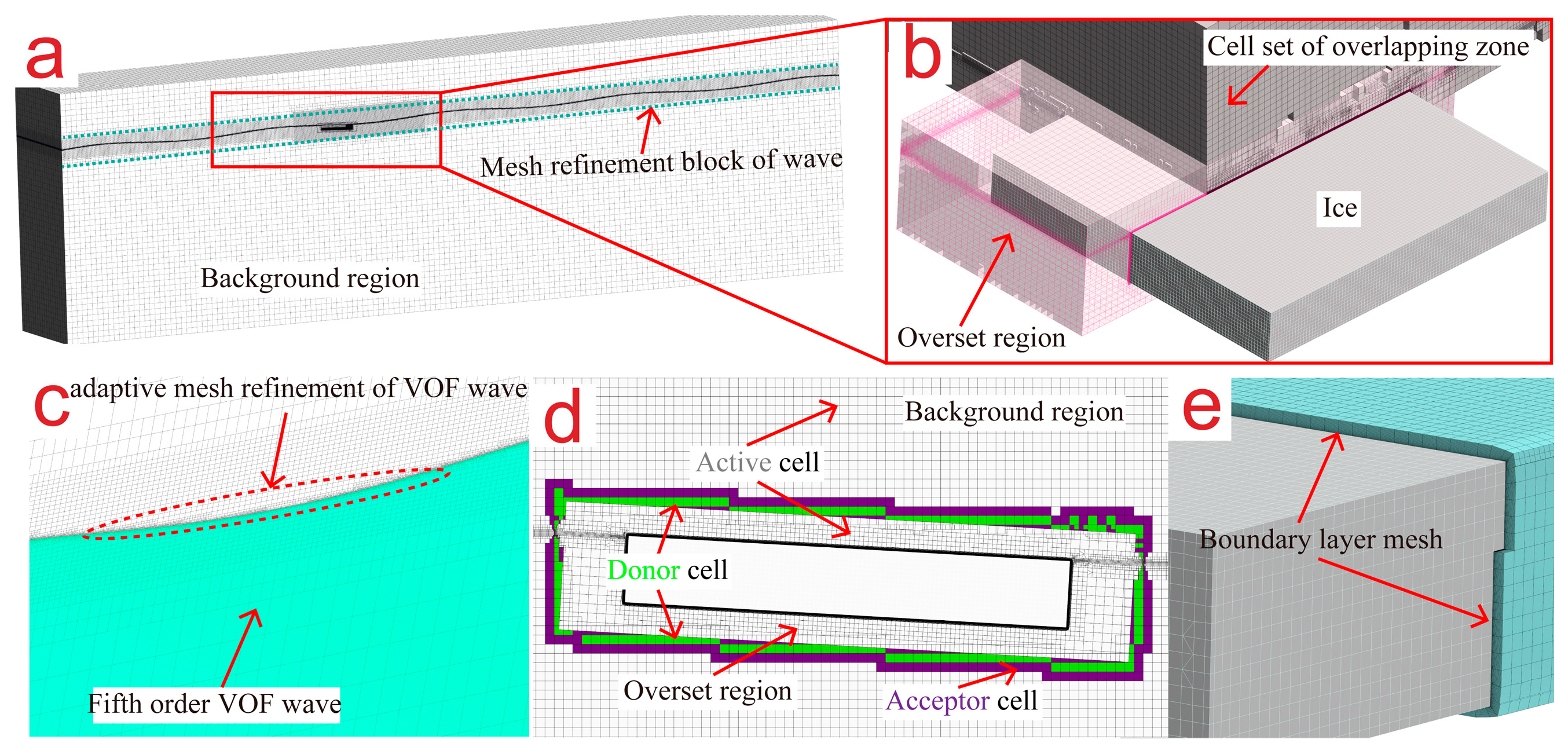
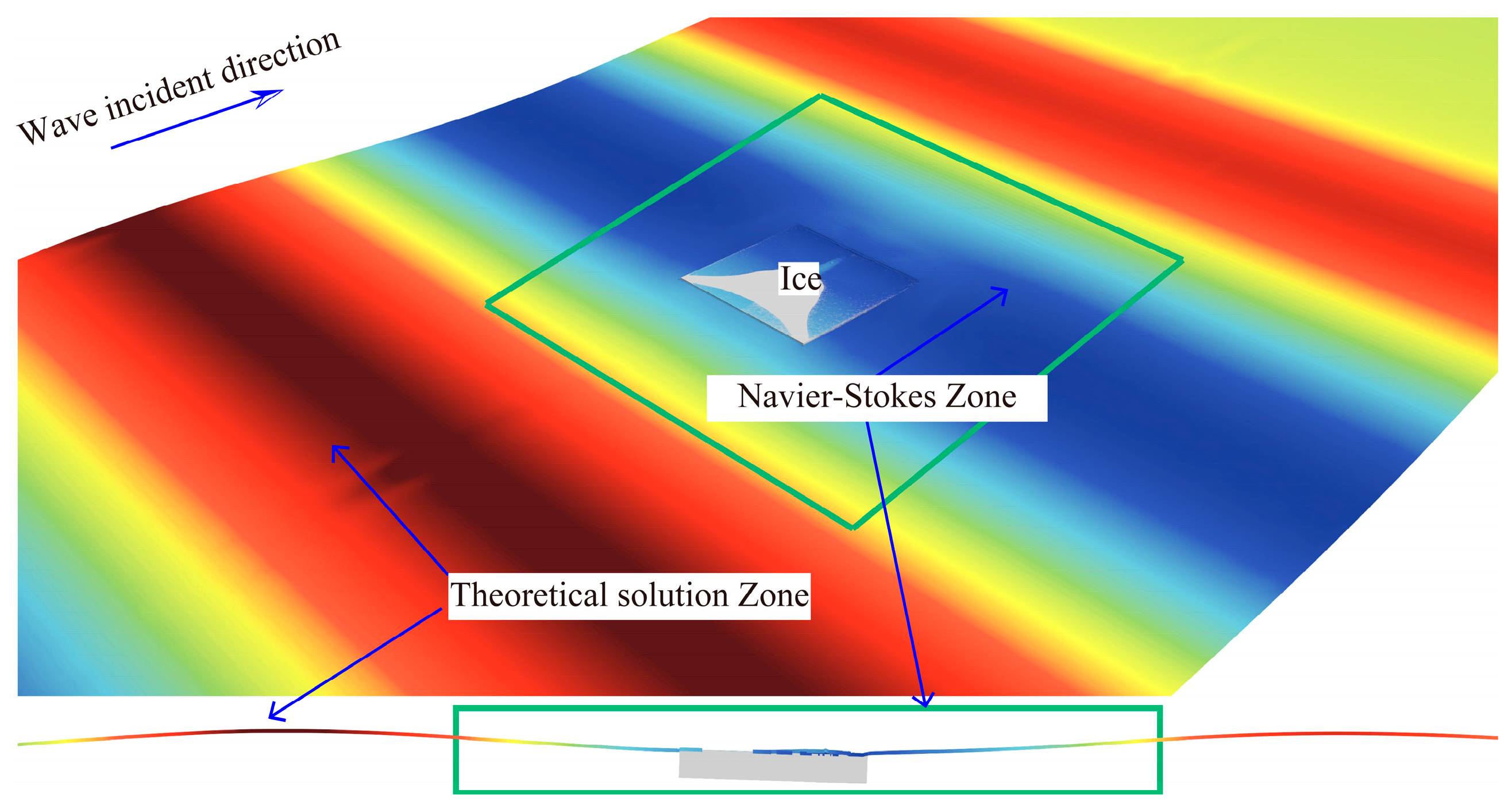

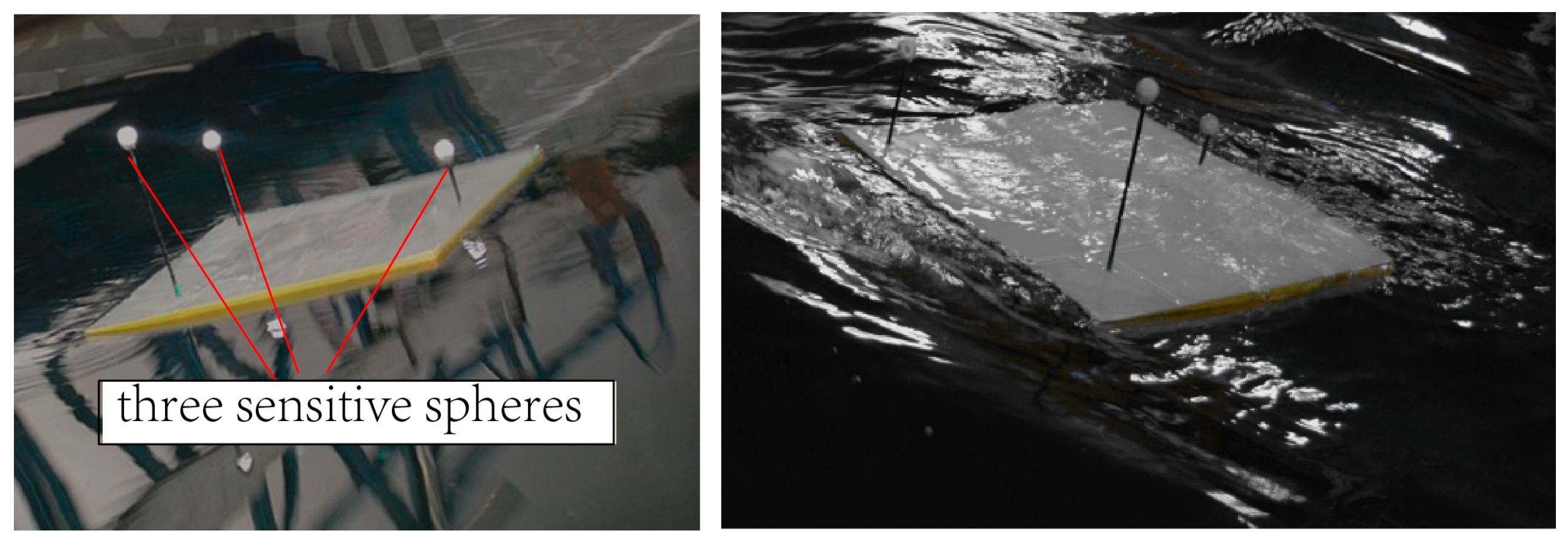
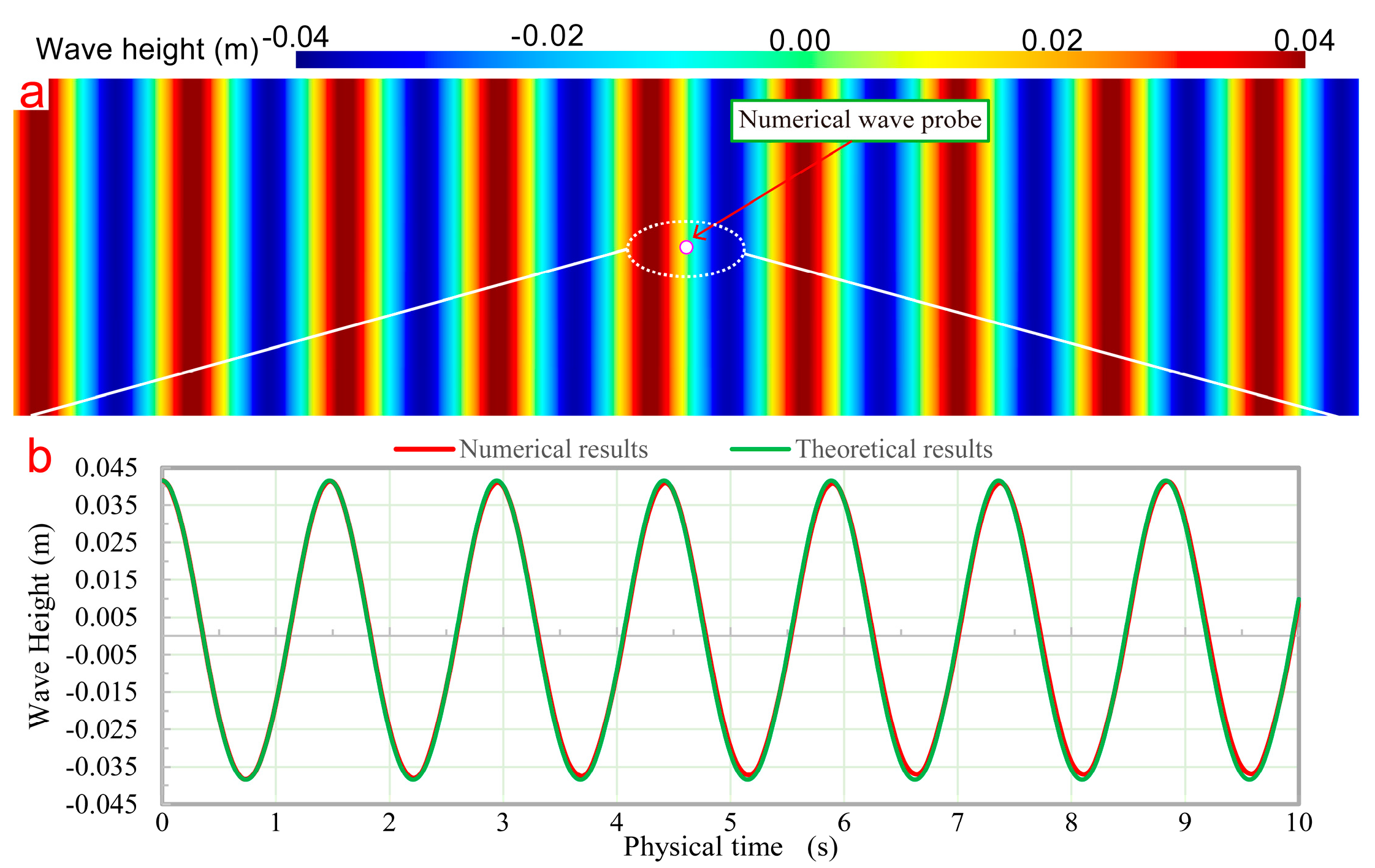
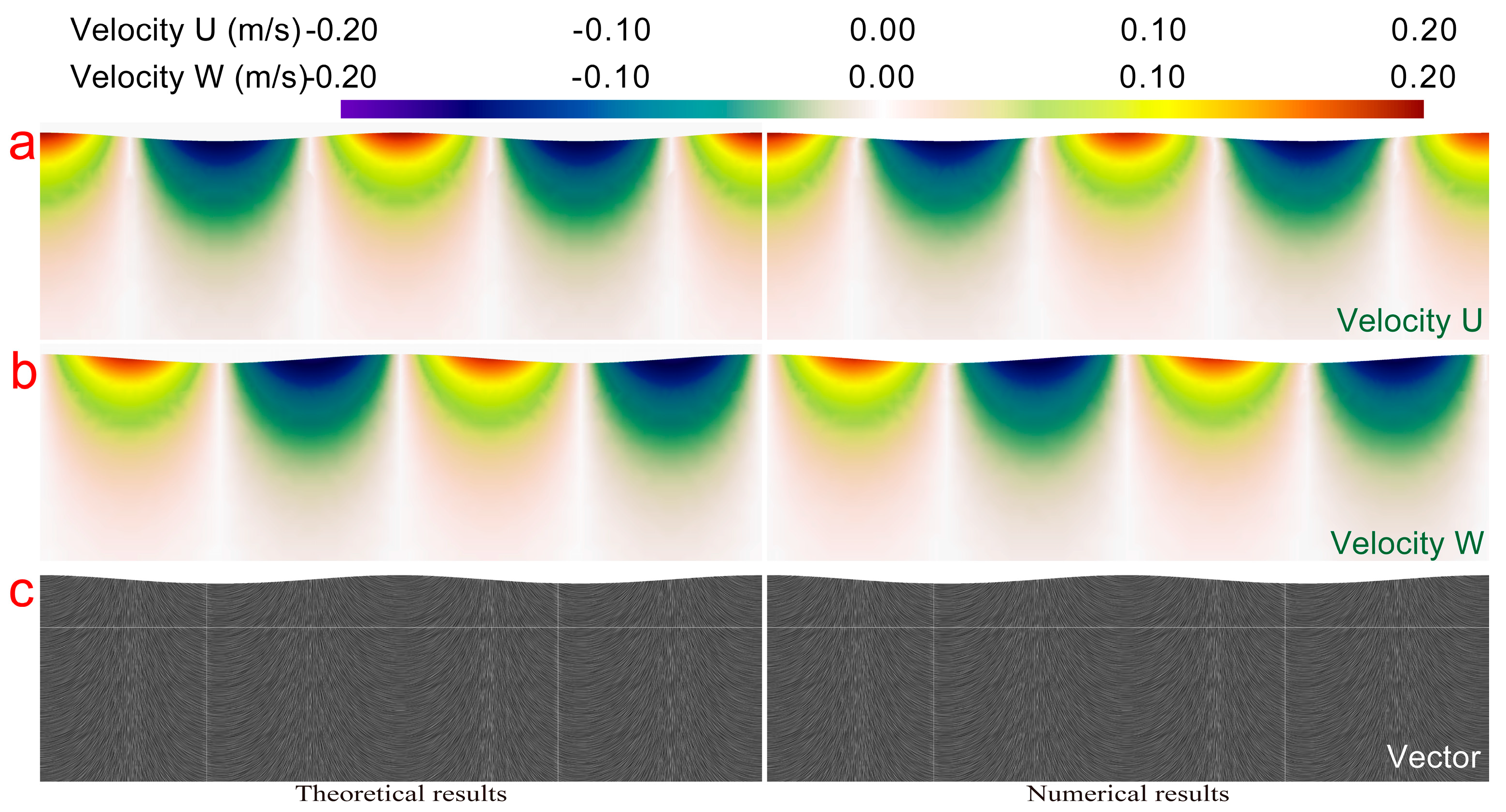

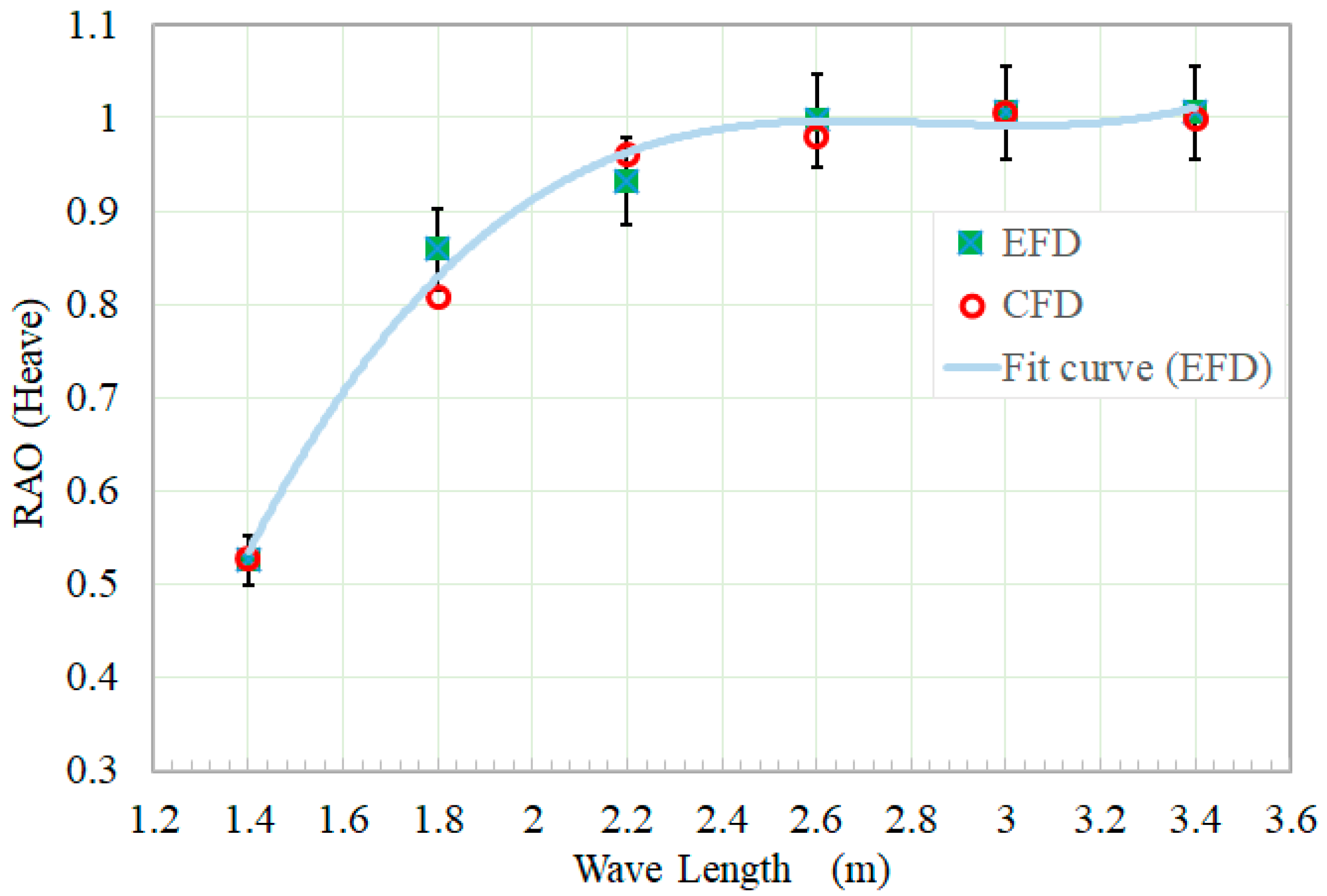
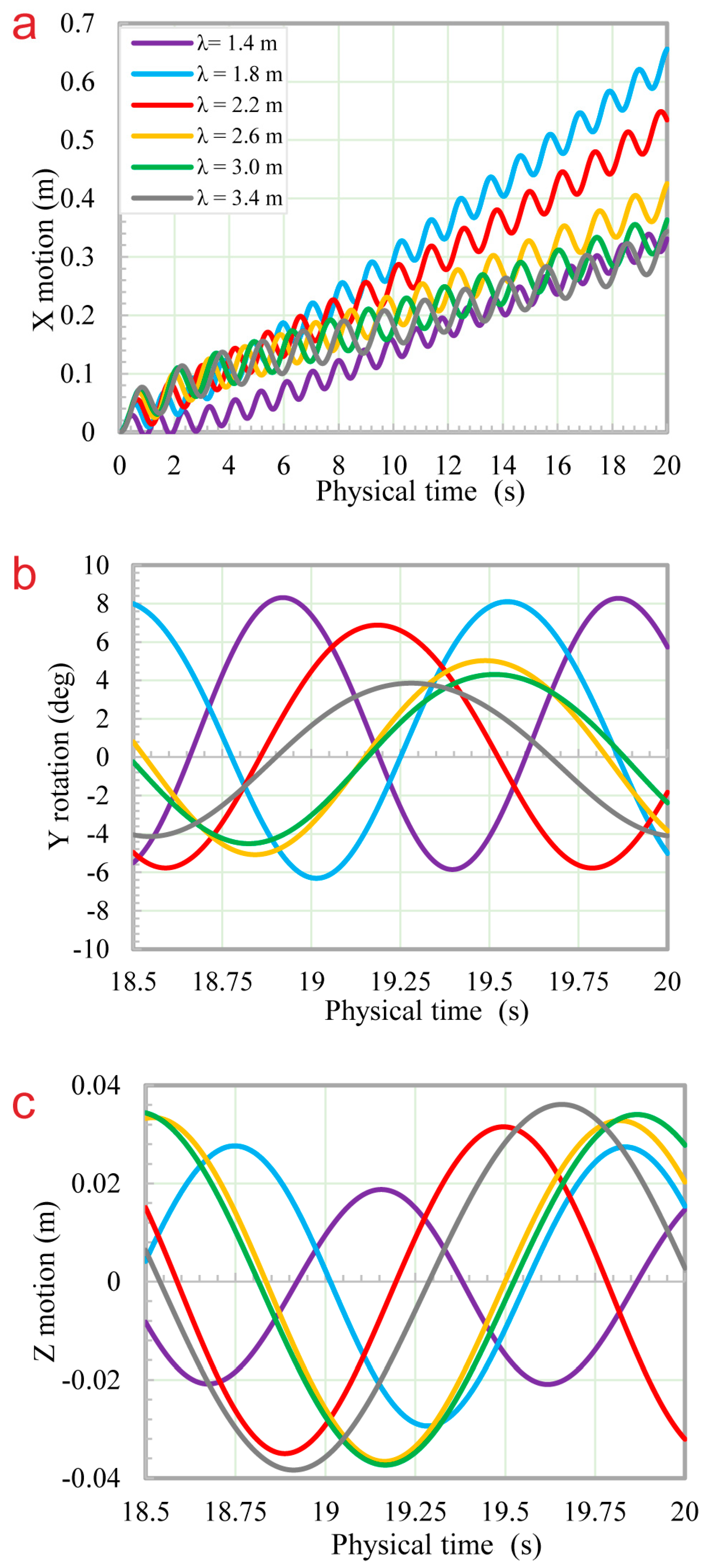
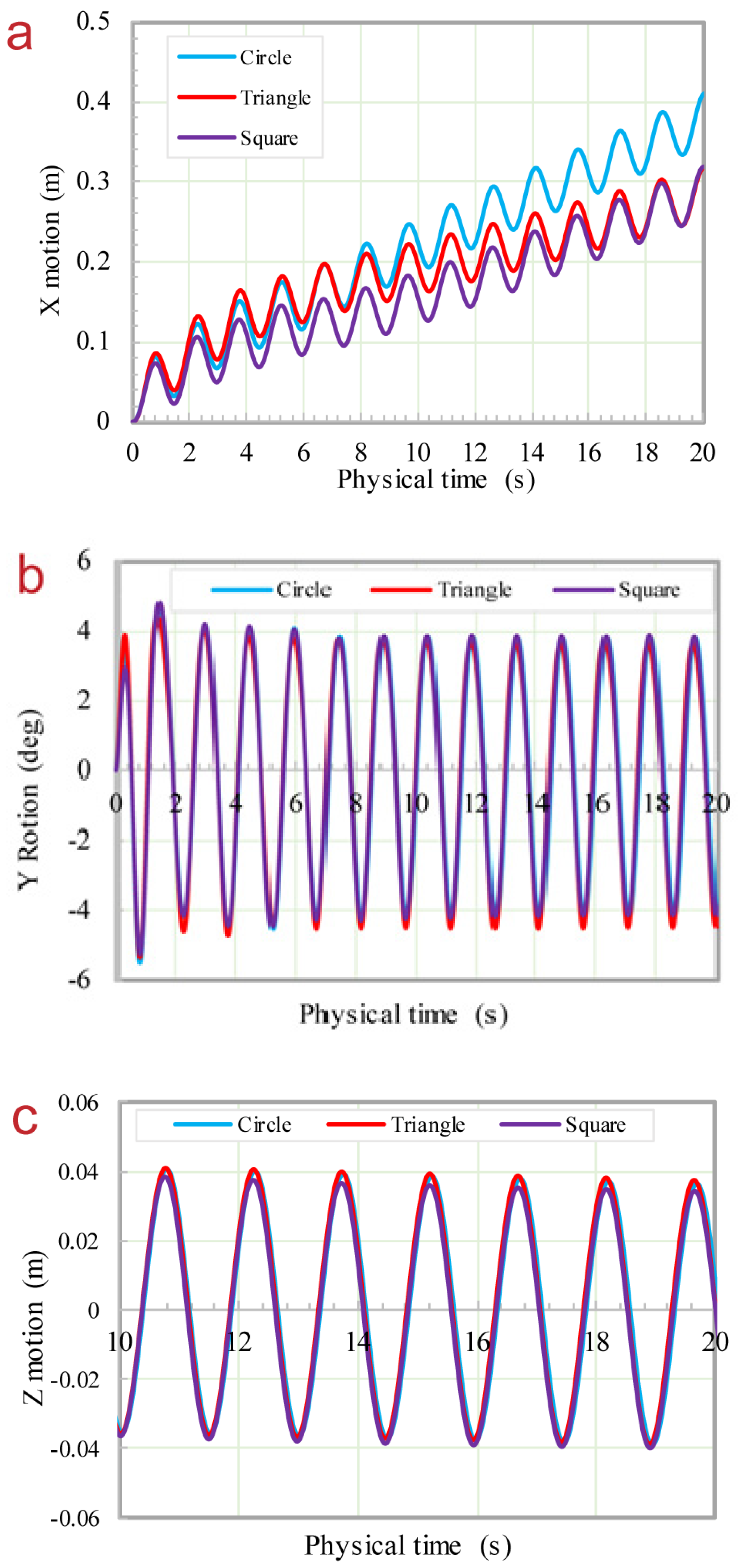
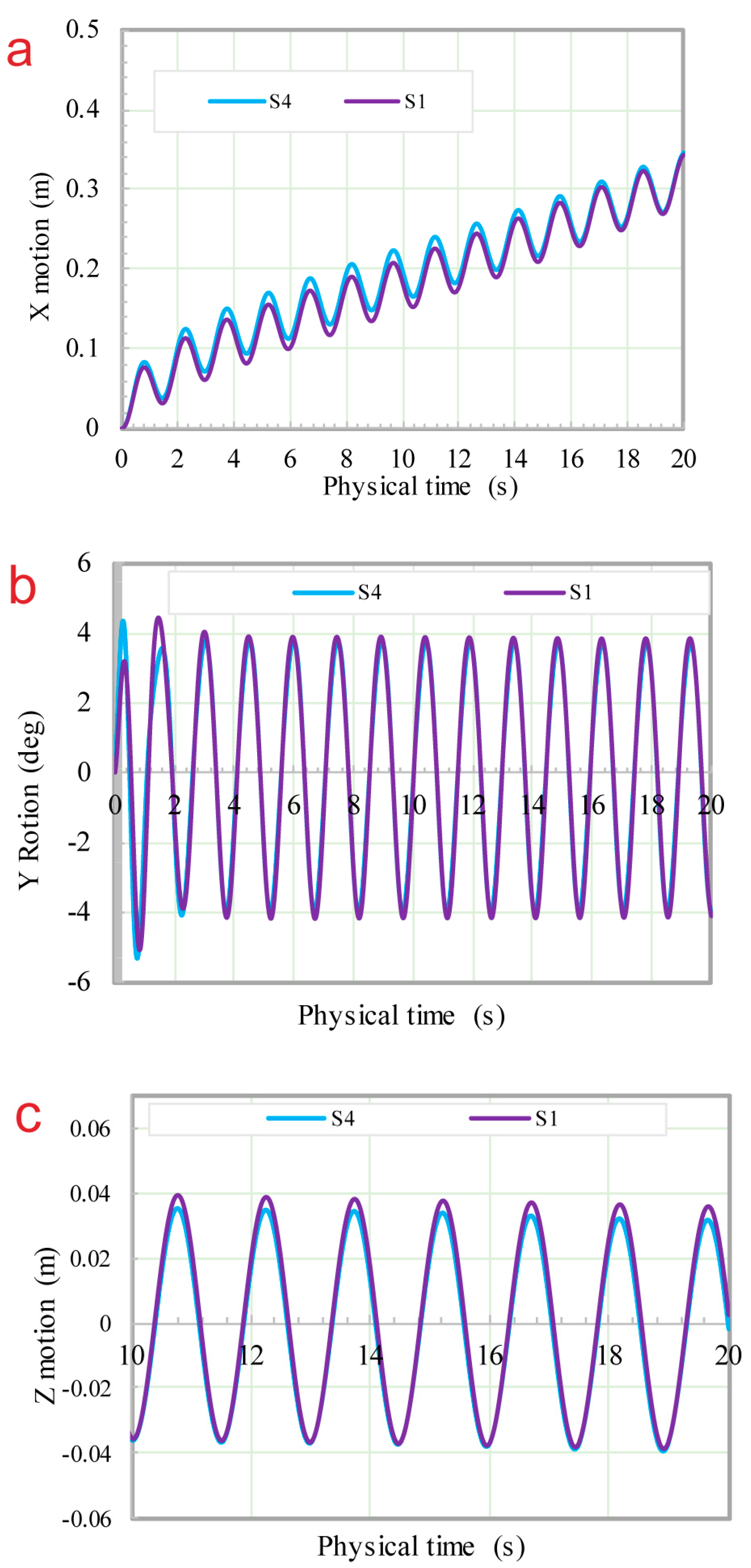
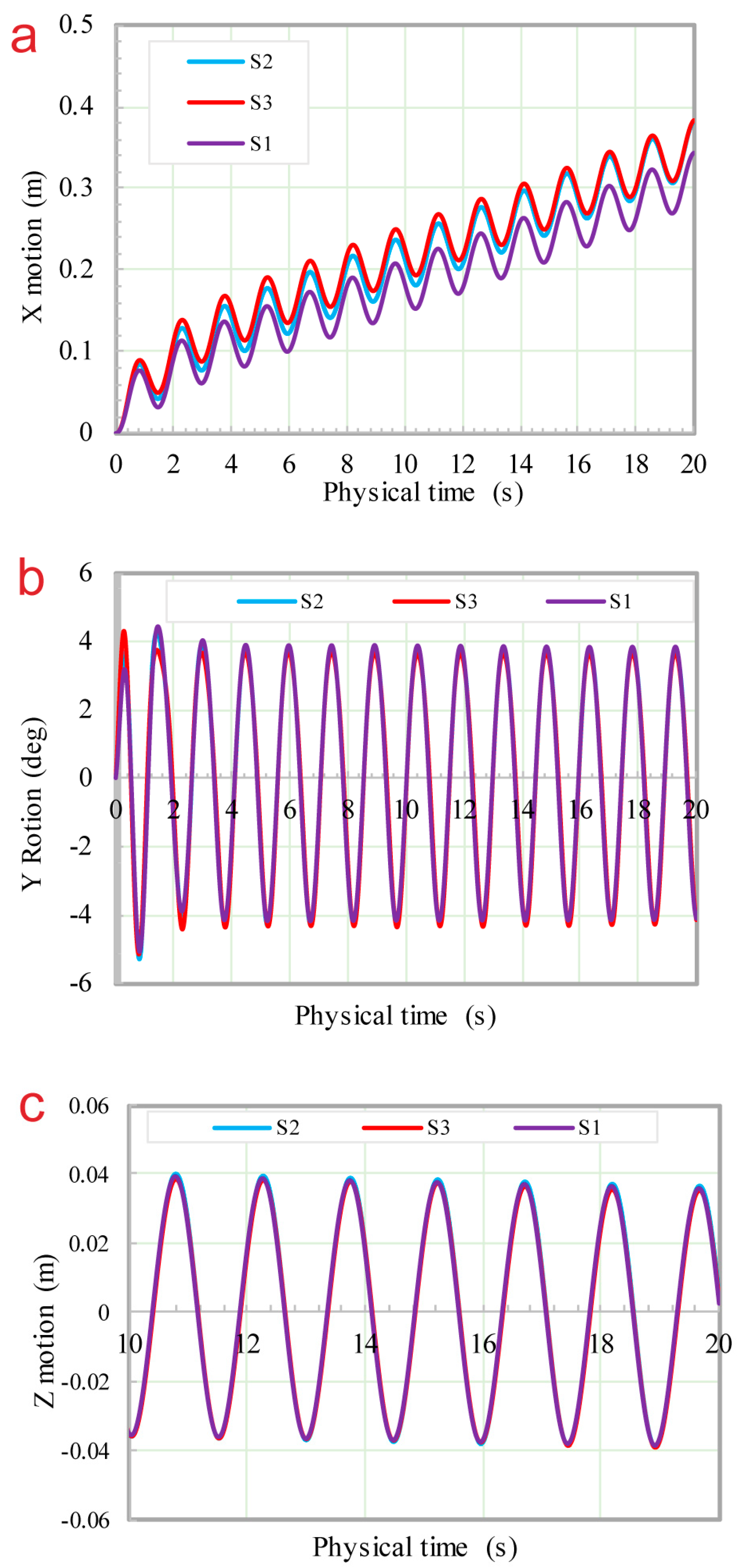
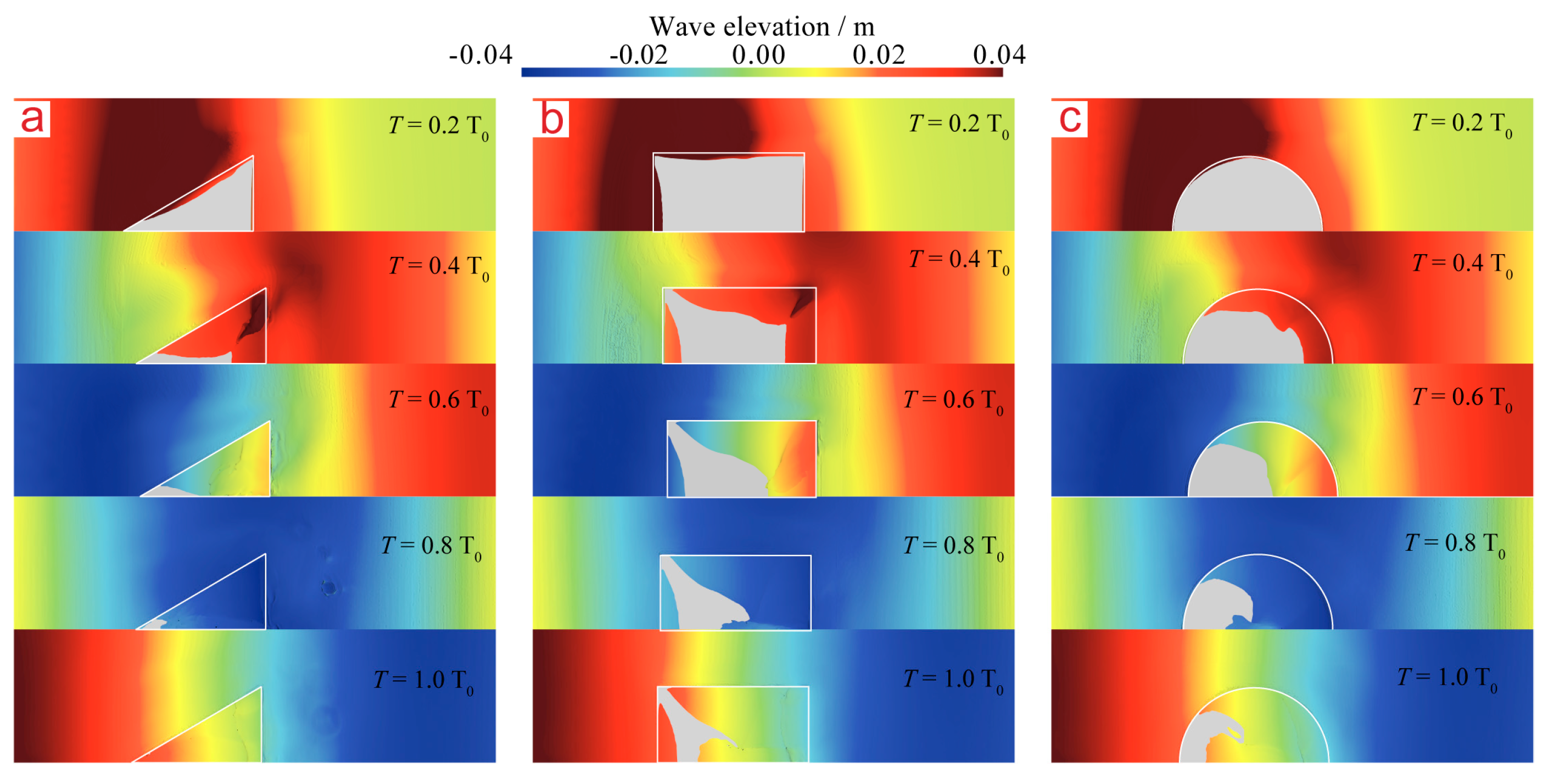
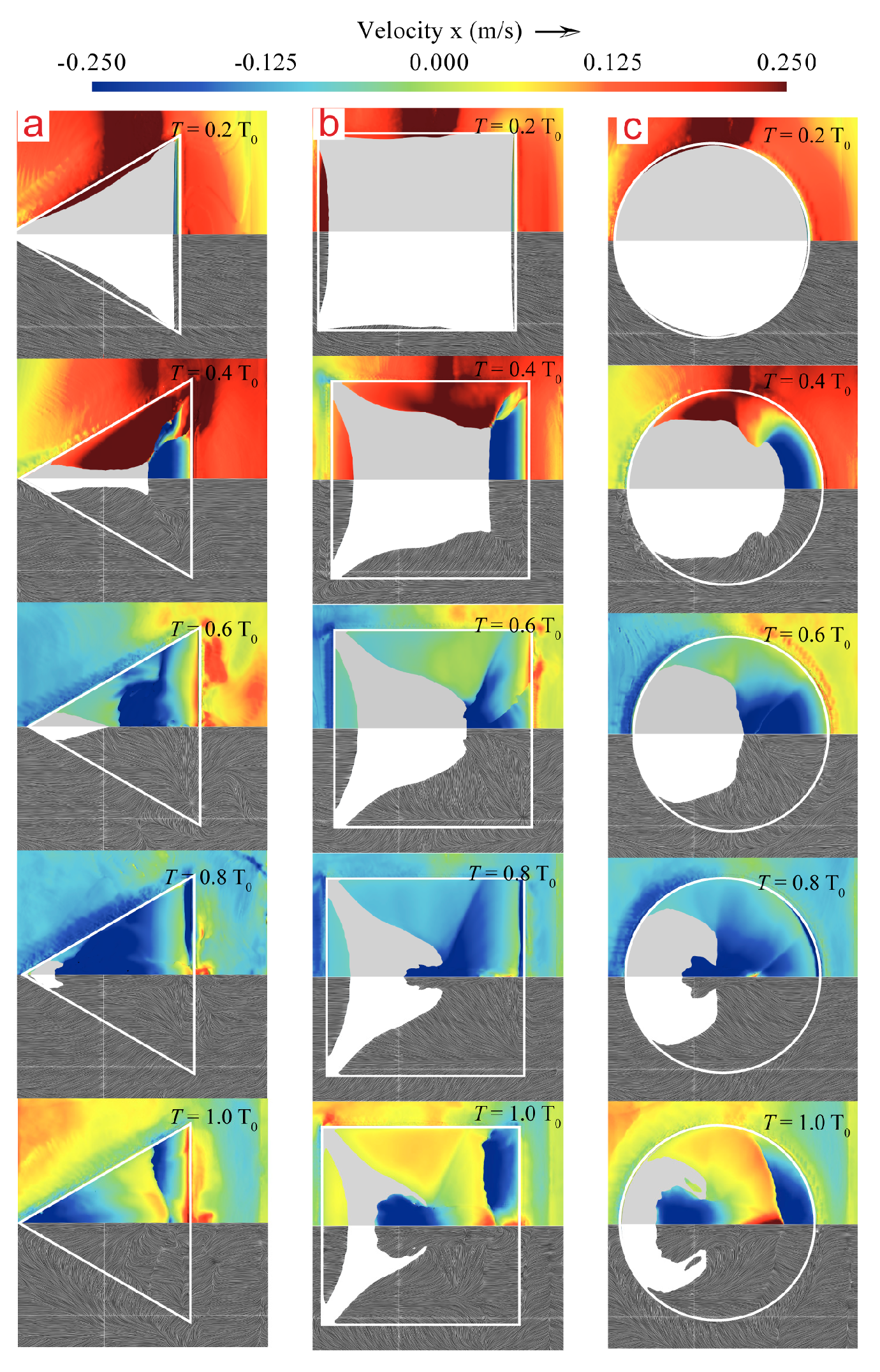
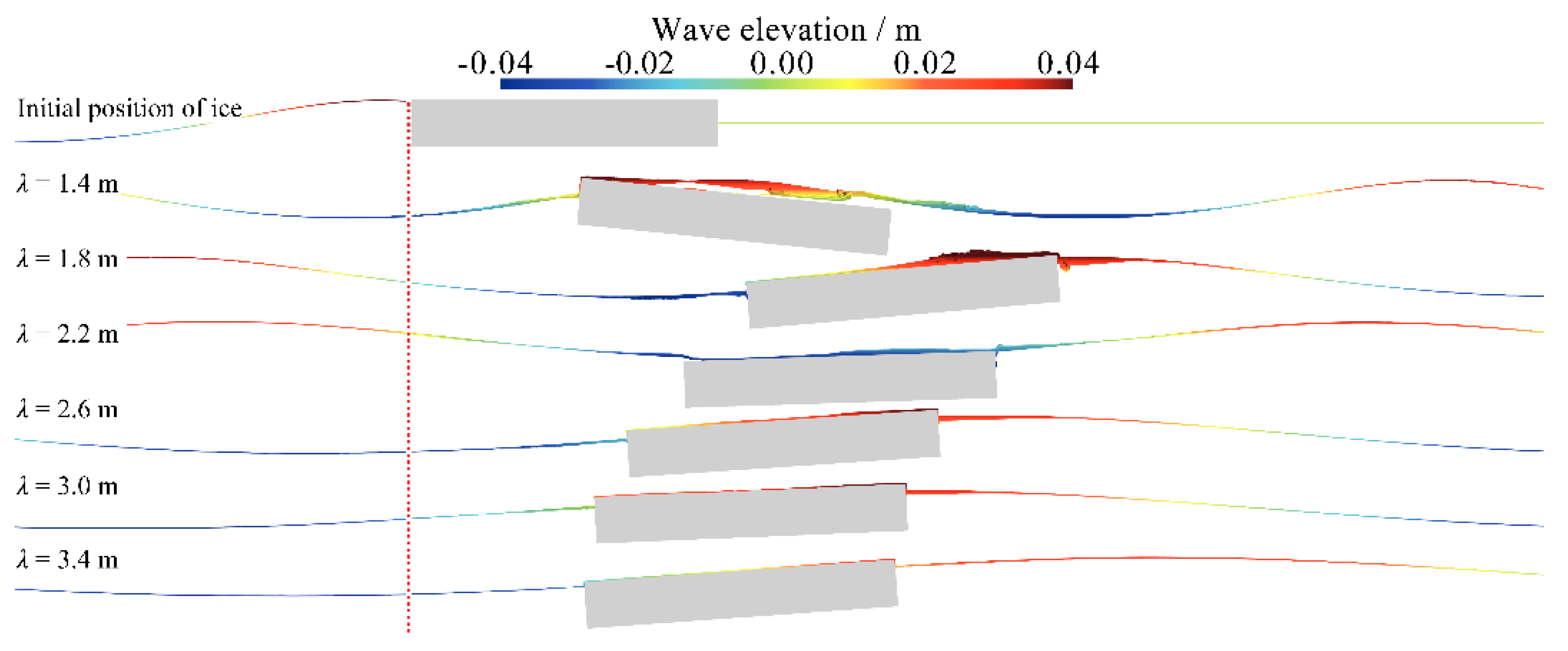
| Model Ice Type | Symbol | Length of Side/Diameter (cm) | Thickness (cm) |
|---|---|---|---|
| Square | S1 | 60 | 9 |
| S2 | 50 | 9 | |
| S3 | 45 | 9 | |
| S4 | 60 | 5 | |
| Circle | C1 | 60 | 9 |
| Triangle | T1 | 60 | 9 |
| Condition Number | Model Ice Type | Wavelength (m) | Wave Height (m) |
|---|---|---|---|
| 1 | S1 | 1.4 | 0.08 |
| 2 | S1 | 1.8 | 0.08 |
| 3 | S1 | 2.2 | 0.08 |
| 4 | S1 | 2.6 | 0.08 |
| 5 | S1 | 3.0 | 0.08 |
| 6 | S1 | 3.4 | 0.08 |
Publisher’s Note: MDPI stays neutral with regard to jurisdictional claims in published maps and institutional affiliations. |
© 2020 by the authors. Licensee MDPI, Basel, Switzerland. This article is an open access article distributed under the terms and conditions of the Creative Commons Attribution (CC BY) license (http://creativecommons.org/licenses/by/4.0/).
Share and Cite
Wu, T.; Luo, W.; Jiang, D.; Deng, R.; Huang, S. Numerical Study on Wave-Ice Interaction in the Marginal Ice Zone. J. Mar. Sci. Eng. 2021, 9, 4. https://doi.org/10.3390/jmse9010004
Wu T, Luo W, Jiang D, Deng R, Huang S. Numerical Study on Wave-Ice Interaction in the Marginal Ice Zone. Journal of Marine Science and Engineering. 2021; 9(1):4. https://doi.org/10.3390/jmse9010004
Chicago/Turabian StyleWu, Tiecheng, Wanzhen Luo, Dapeng Jiang, Rui Deng, and Shuo Huang. 2021. "Numerical Study on Wave-Ice Interaction in the Marginal Ice Zone" Journal of Marine Science and Engineering 9, no. 1: 4. https://doi.org/10.3390/jmse9010004
APA StyleWu, T., Luo, W., Jiang, D., Deng, R., & Huang, S. (2021). Numerical Study on Wave-Ice Interaction in the Marginal Ice Zone. Journal of Marine Science and Engineering, 9(1), 4. https://doi.org/10.3390/jmse9010004






